

Improved text rendering support for grid graphics in R.
You can install the current release from CRAN with
install.packages():
install.packages("gridtext")To install the latest development version of this package, please run the following line in your R console:
remotes::install_github("wilkelab/gridtext")The gridtext package provides two new grobs,
richtext_grob() and textbox_grob(), which
support drawing of formatted text labels and formatted text boxes,
respectively. Both grobs understand an extremely limited subset of
Markdown, HTML, and CSS directives. The idea is to provide a minimally
useful subset of features. These currently include italics, bold, super-
and subscript, as well as changing text color, font, and font size via
inline CSS. Extremely limited support for images is also provided.
Note that all text rendering is performed through a custom-built rendering pipeline that is part of the gridtext package. This approach has several advantages, including minimal dependencies, good performance, and compatibility with all R graphics devices (to the extent that the graphics devices support the fonts you want to use). The downside of this approach is the severely limited feature set. Don’t expect this package to support the fancy CSS and javascript tricks you’re used to when designing web pages.
The function richtext_grob() serves as a replacement for
textGrob(). It is vectorized and can draw multiple text
labels with one call. Labels can be drawn with padding, margins, and at
arbitrary angles. Markdown and HTML parsing is turned on by default.
library(grid)
library(gridtext)
text <- c(
"Some text **in bold.**",
"Linebreaks<br>Linebreaks<br>Linebreaks",
"*x*<sup>2</sup> + 5*x* + *C*<sub>*i*</sub>",
"Some <span style='color:blue'>blue text **in bold.**</span><br>And *italics text.*<br>And some <span style='font-size:18pt; color:black'>large</span> text."
)
x <- c(.2, .1, .7, .9)
y <- c(.8, .4, .1, .5)
rot <- c(0, 0, 45, -45)
gp = gpar(
col = c("black", "red"),
fontfamily = c("Palatino", "Courier", "Times", "Helvetica")
)
box_gp = gpar(
col = "black", fill = c(NA, "cornsilk", "lightblue1", NA),
lty = c(0, 1, 1, 1)
)
hjust <- c(0.5, 0, 0, 1)
vjust <- c(0.5, 1, 0, 0.5)
grid.newpage()
g <- richtext_grob(
text, x, y, hjust = hjust, vjust = vjust, rot = rot,
padding = unit(c(6, 6, 4, 6), "pt"),
r = unit(c(0, 2, 4, 8), "pt"),
gp = gp, box_gp = box_gp
)
grid.draw(g)
grid.points(x, y, default.units = "npc", pch = 19, size = unit(5, "pt"))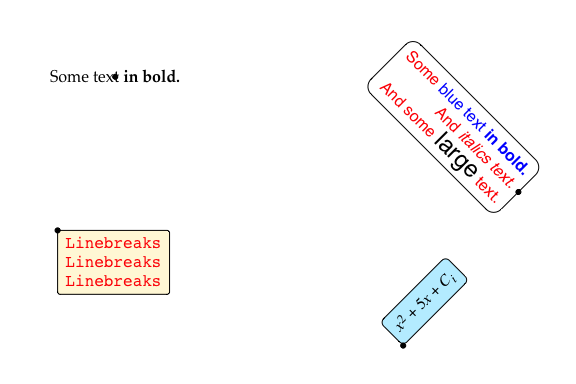
The boxes around text labels can be set to have matching widths
and/or heights, and alignment of text inside the box (specified via
hjust and vjust) is separate from alignment of
the box relative to a reference point (specified via
box_hjust and box_vjust).
text <- c("January", "February", "March", "April", "May")
x <- (1:5)/6 + 1/24
y <- rep(0.8, 5)
g <- richtext_grob(
text, x, y, halign = 0, hjust = 1,
rot = 45,
padding = unit(c(3, 6, 1, 3), "pt"),
r = unit(4, "pt"),
align_widths = TRUE,
box_gp = gpar(col = "black", fill = "cornsilk")
)
grid.newpage()
grid.draw(g)
grid.points(x, y, default.units = "npc", pch = 19, size = unit(5, "pt"))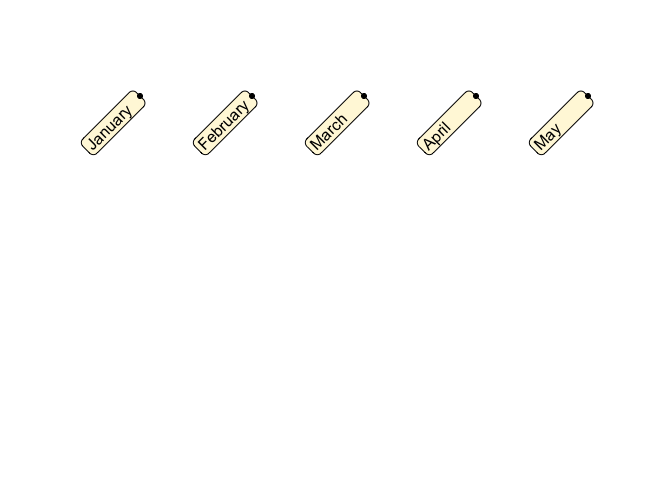
Basic support for images is available as well. As of now, images will always be vertically aligned with the baseline of the text.
grid.newpage()
img_src <- system.file("extdata", "Rlogo.png", package = "gridtext")
text <- glue::glue("Image with native aspect ratio: <img src='{img_src}' width='100'/> And some more text.")
grid.draw(richtext_grob(text, x = 0.9, y = 0.7, hjust = 1))
text <- glue::glue("Image with forced size: <img src='{img_src}' width='100' height='30'/> And some more text.")
grid.draw(richtext_grob(text, x = 0.9, y = 0.3, hjust = 1))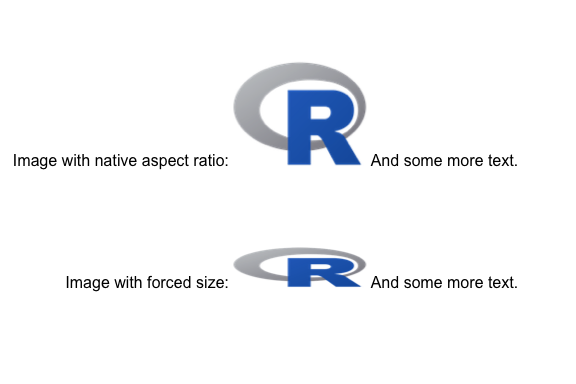
The function textbox_grob() is intended to render
multi-line text labels that require automatic word wrapping. It is
similar to richtext_grob(), but there are a few important
differences. First, while richtext_grob() is vectorized,
textbox_grob() is not. It can draw only a single text box
at a time. Second, textbox_grob() doesn’t support rendering
the text box at arbitrary angles. Only four different orientations are
supported, corresponding to a rotation by 0, 90, 180, and 270
degrees.
g <- textbox_grob(
"**The quick brown fox jumps over the lazy dog.**<br><br>
The quick brown fox jumps over the lazy dog.
The **quick <span style='color:brown;'>brown fox</span>** jumps over the lazy dog.
The quick brown fox jumps over the lazy dog.",
x = unit(0.5, "npc"), y = unit(0.7, "npc"),
gp = gpar(fontsize = 15),
box_gp = gpar(col = "black", fill = "lightcyan1"),
r = unit(5, "pt"),
padding = unit(c(10, 10, 10, 10), "pt"),
margin = unit(c(0, 10, 0, 10), "pt")
)
grid.newpage()
grid.draw(g)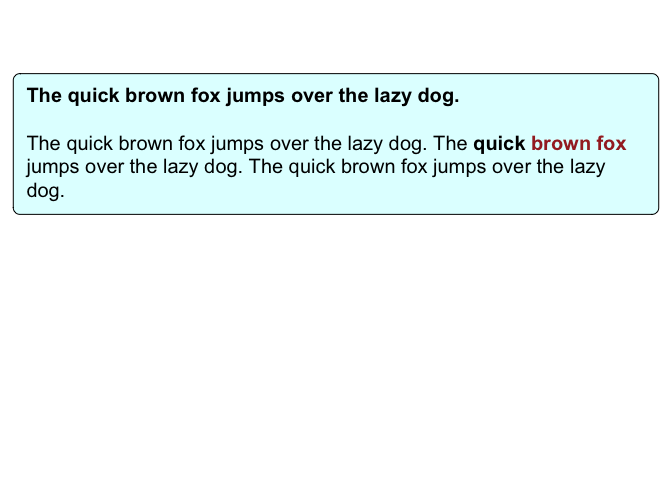
The alignment parameters hjust, vjust,
halign, and valign function just like they do
in richtext_grob().
g <- textbox_grob(
"**The quick brown fox jumps over the lazy dog.**<br><br>
The quick brown fox jumps over the lazy dog.
The **quick <span style='color:brown;'>brown fox</span>** jumps over the lazy dog.
The quick brown fox jumps over the lazy dog.",
x = unit(0.2, "npc"), y = unit(0.5, "npc"),
hjust = 0.5, vjust = 1, halign = 1,
gp = gpar(fontsize = 15),
box_gp = gpar(col = "black", fill = "lightcyan1"),
r = unit(5, "pt"),
padding = unit(c(10, 10, 10, 10), "pt"),
margin = unit(c(0, 10, 0, 10), "pt"),
orientation = "left-rotated"
)
grid.newpage()
grid.draw(g)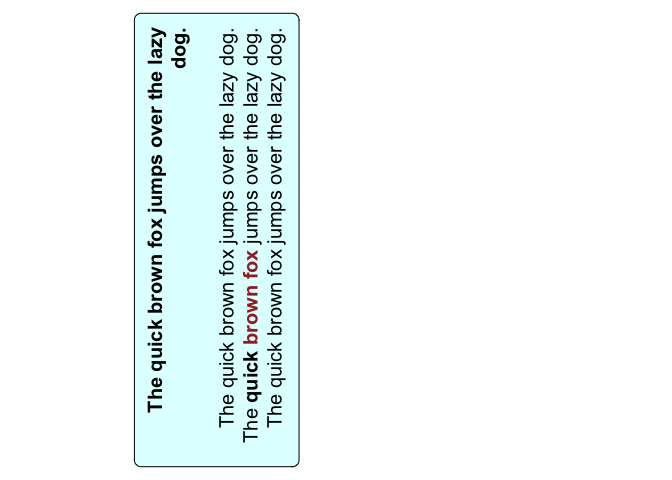
This project received financial support from the R consortium.
